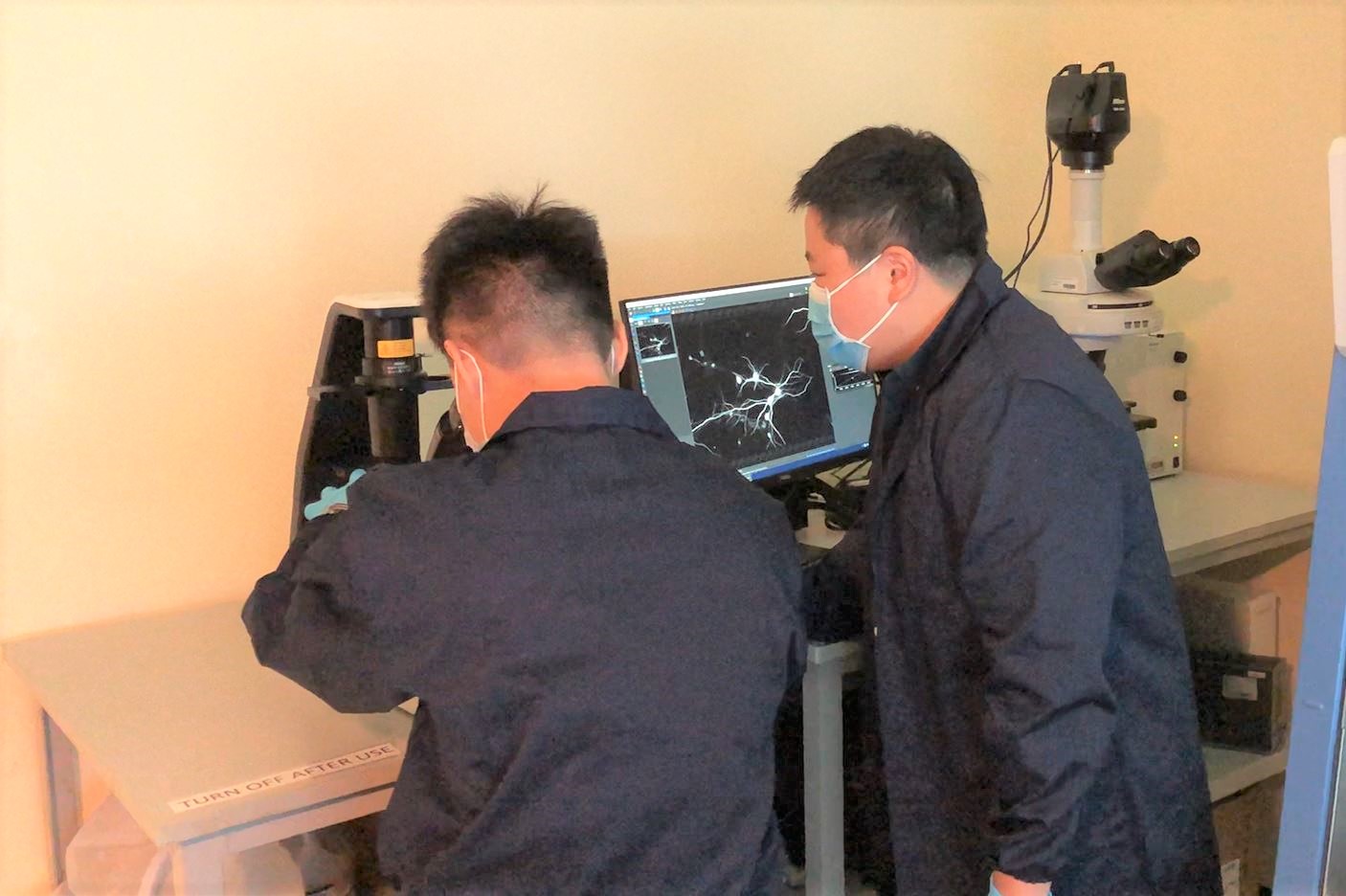Our Eminent Scientists @ CUHK:
Big Data X Traditional Molecular Biology: Decoding Biological Signalling Network
Prof. CHOW Hei Man Kim
School of Life Sciences
Big Data X Traditional Molecular Biology: Decoding Biological Signalling Network
Human are complex organisms that made up of million individual systems. Scientists have been working hard in dissecting the mechanisms regulating human physiology but the knowledge that we have seems just to be the tip of the iceberg. Professor CHOW Hei Man Kim has joined the School of Life Sciences as Assistant Professor in 2019. She was the first from Hong Kong who was selected for the 2017 L’Oreal-UNESCO-China Association for Science and Technology: Rising Talent for Women in Science National Fellowship in China, a programme aims at recognising women scientists who are with great achievements in their fields. Recently, she has been awarded the Excellent Young Scientists Fund 2020 from the National Natural Science Foundation of China (NSFC). CHOW will share how she uses innovative interdisciplinary research approaches to decode the signalling pathways in neurodegenerative diseases.
The Underlying Mechanisms of Rare Genetic Cerebellar Ataxia
Professor CHOW’s research project, which has recently been awarded China’s Excellent Young Scientists Fund 2020, focuses on a rare genetic disease named Ataxia Telangiectasia (AT). The disease results from a mutation in the Ataxia Telangiectasia mutated gene (ATM gene) and the defects in such gene can cause the synthesis of abnormal ATM protein. Before probing deep into CHOW’s research, let’s first understand how DNA and its repair mechanism function.
DNA stores genetic materials and serves as the blueprint for protein synthesis. Any damage in it may lead to interruption in protein synthesis and/or DNA replication, and eventually result in cell death or the formation of malignant tumours, also known as cancers. Reasons for causing damage in DNA vary but repairing it is a fundamental process inside our body to help protect our cells. During cell cycle, the process which cells proliferate and divide, any DNA defect identified will suspend the whole cycle and specific enzymes will then repair the DNA to resume the cycle.
ATM protein plays a vital role in pausing the cell cycle for DNA repairing. Any abnormality in this type of protein may disrupt the cell cycle, and the newly divided cells will inherit the damaged DNA and bring cancer. This helps explain why patients suffering from AT will have a predisposition to cancers such as lymphoma and leukaemia. Another symptom which suffers every patient is the uncoordinated movements due to cerebellar ataxia; the situation even gets worse before one enters puberty.
CHOW was intrigued by the symptoms that AT patients have and their underlying mechanisms. First, abnormal ATM protein exists since the first day of birth in AT patients but the symptom of lacking movement coordination becomes apparent until pre-puberty. Second, abnormal ATM protein is in all body cells, but why are the Purkinje cells located in the cerebellum, responsible for controlling motor movement, mostly affected? The Purkinje cells, a type of neurones which will not undergo cell division, are supposed to be immune to the cell cycle interruption induced by abnormal ATM protein, but it turns out to be the opposite.
To solve the mystery, CHOW decided to adopt a data driven approach by combining metabolomic and transcriptomic analyses when studying this complex genetic neurodegenerative disorder. Instead of taking the conventional approach to study cell signalling pathway, she tried to decode the metabolic reprogramming mechanism of Purkinje cells by comparing the big data collected from the cerebellum samples of AT patients and those under the same age, and later discovered that the pathogenesis of cerebella ataxia is related to the cellular fuel metabolism of which imbalance is found in AT patients. It was known that the cerebellum reaches the highest in its development before one enters puberty. Research studies also found that for AT patients, the high demand on cerebellar cells and neurones causes energy depletion and results in cell atrophy due to the presence of abnormal ATM proteins. But why are the Purkinje cells found to be damaged most? It is because this type of cells, as one of the largest brain cells with more than 200k synapses, is the only cerebellar cell responsible for the firing of neuron impulse to control our body movement.
The research staff was observing the morphology of neurones under the guidance of Professor CHOW.
With the computation model, CHOW discovered that the firing process, involving countless Purkinje cells to work together simultaneously and in high frequency, consumes enormous cellular energy; the level of energy consumed by Purkinje cells is 4 and 60 times higher than that consumed by pyramidal and granule cells respectively. The demand of energy is such high that it can spell disaster for Purkinje cells carrying abnormal ATM proteins, which in turn affects the motor coordination and cerebellum development of AT patients. It is long believed that cerebellar ataxia is caused by the malfunction of ATM in repairing DNA, but CHOW’s approach, supported by abundant and convincing data, helps explain the pathogenesis of AT with neuronal metabolic reprogramming mechanism.
From Life Scientist to Data Analyst
It was since childhood that CHOW has been interested in life sciences. She received her Master and Doctorate degrees from the University of Hong Kong with thesis topics on diabetes and breast cancer respectively. When pursuing her postgraduate studies, she realised that the hyperglycaemia in diabetic patients may trigger WNT/beta-catenin signalling pathway, which will stimulate carcinogenesis and promote cancer cell proliferation; she also learnt that the complexity in human body cannot be explained merely by a single pathway.
Later, she joined the team at the School of Electrical and Computer Engineering in Cornell University as a Postdoctoral Fellow to further the cell signalling research. As early as in 2010, it has been common in the US to conduct interdisciplinary research, as a way to solve problems whose solutions are beyond the scope of an area of research practice. When investigating the roles of various molecules in human signalling pathways, her team collected data from conventional biological experiments and started carrying out big data analysis, which was not a prevailing research approach at that time. The training that she received at Cornell has undoubtedly laid the foundation for her to develop her career beginning with interdisciplinary research.

CHOW adopts an interdisciplinary approach by combining big data analysis to small things like molecular and structural biology. She can analyse massive amount of molecular data within a short period of time, and the efficient research method and data-driven results facilitate her to determine the most feasible regulatory mechanism.
Paving the Way for Neuroscience Research
To look after her family member who was suffering from recurring illness, there was time that CHOW suspended her postdoctoral fellowship at Cornell and returned to Hong Kong. However, the routine work of medical science liaison worn her out and spurred the young scientist to return back to her favourite field, scientific research.
Though she had no relevant experience in neuroscience research at that time, the previous training in cancer that she received and knowledge in WNT pathway that she had matched with the research specialty of Professor Karl HERRUP, an expert in neurodegenerative diseases, so she joined his team at the Hong Kong University of Science and Technology as a Postdoctoral Fellow, paving the way for her neuroscience research.
Taking Great Satisfaction
The training and experience that CHOW had before inspired and influenced her a lot when she develops her own research career. It is a very common practice in the field that the principal investigator will formulate a research design following his/her own research specialties and personal interests so that s/he can contribute his/ her knowledge to the research. However, such practice may limit the potential research impact; the results, though not significant in the targeted signalling pathway, can be promising in outlining other different pathways. The research infrastructure, including the equipment, sample size, funding available for conventional wet lab experiments may also limit researchers to study multiple signalling pathways within limited time.
CHOW resolved the dilemma by adopting an interdisciplinary approach. Combining big data analysis to small things like molecular and structural biology, she can analyse massive amount of molecular data within a short period of time, and the efficient research method and data-driven results facilitate her to determine the most feasible regulatory mechanism. The revolutionary big data analytics also empowers scientists to precisely predict the mode of action that candidate compounds will have in body pathways, speeding up the hit-to-lead phase in early drug discovery.
“The research grants offered by funding commissions emphasise how scientific research helps improve human’s life and living, rather than the specialties of the researchers. Though there will still be a long journey for my current research to make an impact, studying on it does unravel the mysteries that I had towards science and scientific research, and I enjoyed the deep satisfaction from this exciting journey. To be honest, I chose to study biology because I was reluctant to numbers and mathematics. But now, my life is filled with data and I even have to search for and learn new methods to process and analyse them every day. The process can be tough to me sometimes, but I would rather describe it as a rewarding and worthwhile one, especially when you learn that the results driven from rigorous experiments are convincing and supported by data and solid evidence”, said CHOW.
Lifelong Learning
From being the first in Hong Kong to be selected for the 2017 L’Oreal Talent for Women in Science National Fellowship to receiving the China’s Excellent Young Scientists Fund 2020, the recognition is the fruit of CHOW’s endeavours and perseverance. She shared that keep acquiring new skills is the key to adapting the fast-changing and hyperconnected world and research environment.

CHOW (second from left) was awarded the 2017 L’Oreal Talent for Women in Science National Fellowship.
(Photo Credit: Beijing-Hong Kong Academic Exchange Centre)
Apart from continuing the study of underlying mechanisms of metabolic reprogramming in cerebellar ataxia with the help of machine learning algorithm, CHOW will also investigate the efficacy of conventional drug combination and its synergistic effects on treating neurodegenerative diseases. She will also investigate the role of various micronutrients in neurodegeneration pathogenesis by testing the feasibility of precision medicine-nutrition approach. If the results are found to be promising, personalised therapies can be formulated in a tangible and inexpensive manner favourable for patients suffering from neurodegenerative disorders.
Text: Angela HUNG | Editing: Cindy SUNG















